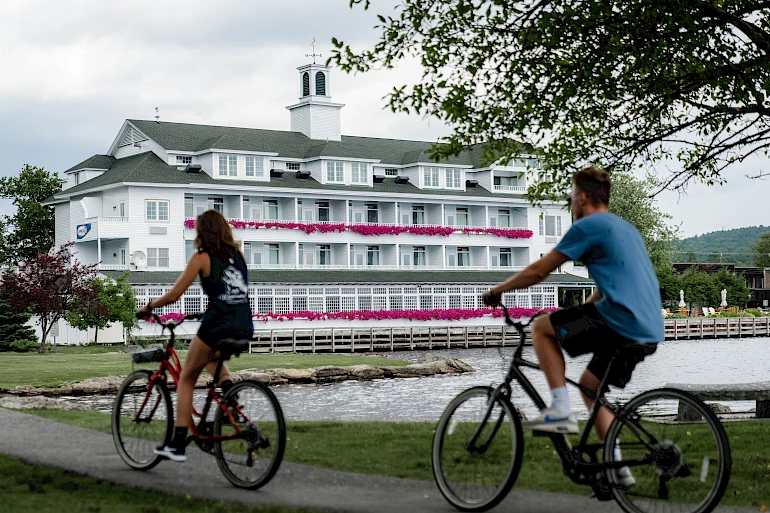One Lakefront Resort.
Four Distinct Stays.
CHURCH LANDING | BAY POINT | CHASE HOUSE | THE INN AT MILL FALLS
CHURCH LANDING | BAY POINT | CHASE HOUSE | THE INN AT MILL FALLS
At Mill Falls at the Lake, stay your way. Discover a collection of four distinct accommodations, each with its own personality and advantages, at one waterfront resort.
No matter where you sleep, enjoy access to the lake and to the resort’s rich amenities and abundant activities. All of our lodgings are within easy walking distance of each other.
Boasting laidback luxury and a coveted front row seat to the lake, Church Landing treats guests to 70 spacious and elegantly designed guest rooms. Sleep soundly on plush beds and wake up with coffee on your balcony overlooking the serene lake.
Grandly presiding over a cove in Meredith Bay, Bay Point is dripping in coastal charm and breathtaking vistas of the water. The quaint, 24-room inn offers crisp nautical touches, amenities such as whirlpool tubs and fireplaces, and is filled with all-access views of the lake thanks to inviting window seats and balconies that float over the water.
Located directly across the street from Meredith Bay, the Chase House flaunts views of the bustling Town Docks and positions guests just steps away from Meredith’s village life. All 21 guest rooms are built for your comfort, with crackling fireplaces, lake views, and some with two-person whirlpool baths.
Stay where it all began. Rich in history, the Inn at Mill Falls presents the unique opportunity to sleep in a restored 19th-century linen mill. With the feeling of a country inn, the 54-room hotel caters to families with an indoor pool and a prime location adjacent to The Marketplace’s eclectic shops and eateries.
Reserve your stay in one of our residential-style accommodations. Our private cottages along Lake Winnipesaukee are ideal for families and larger groups seeking privacy.
Our photos depict a specific type of room and not a specific room. Rooms within each type vary in layout & furnishings.

A resort fee of $35.00 plus tax per day is applied to each reservation in order to provide you with the following services and amenities listed above as well as the below to provide an enhanced guest experience.
10% Off Weekday Pontoon Boat Charters & Rentals (Seasonal)
24/7 Water, Tea & Coffee in Guestrooms & Lobbies
Access to 2 Fitness Centers
Access to 3 Pools & Hot Tubs (Indoor/Outdoor)
Access to Puzzles, Board & Card Games, and Library Reading Room in Church Landing
High Speed Wireless Internet Access
On Site Spa & Rooftop Treatment Deck (Fees Apply Based on Service Selected)
Direct Lake Access & Swimming at Church Landing
Paddleboard & Kayak Usage at EKAL Activity Center from 8 to 11 AM Daily (Seasonal)
Access to EKAL Activity Center
Resort Activities (Schedule Subject to Change)
Weekend Bonfires & S’mores (Friday/Saturday Evenings, Subject to Availability)
Discounts at the Mill Falls Marketplace Shops (Seasonal)
Self-Parking
Snacks in the Inn Lobbies
Welcome Reception on Friday Afternoons
4 On-Site Restaurants

No matter where you choose to stay, you will have access to amenities at all properties within our resort.
Church Landing:
Indoor & outdoor pools and hot tubs
Complimentary pool towels
EKAL activity center & bicycle rentals
Fitness center with Peloton bikes
Lake access for swimming
Electric vehicle charging stations
Lodge Building:
Indoor & outdoor adult only pool
Foosball table
Inn at Mill Falls:
Indoor pool and hot tub
Complimentary pool towels
Fitness center
All Buildings Feature:
Air conditioning
Comfortable common areas and business center
Complimentary coffee + tea in the lobby
Complimentary local calls + wireless internet access
Complimentary parking
In-room mini fridge, coffee maker, hair dryer, iron + ironing board, cable TV
Pet Policy. Pet-friendly rooms are available at Church Landing and The Inn at Mill Falls, and are only bookable via phone. 844.745.2931. Restrictions may apply.